 The growth of the diaconate has prompted a reporter from Religion News Service to look into the vocation — and the resulting article has a few familiar names:
The growth of the diaconate has prompted a reporter from Religion News Service to look into the vocation — and the resulting article has a few familiar names:
He’s performed so many funerals, they call him “Burying Joe.”
A recent Saturday afternoon found Joe Krysiak again at a cemetery, his white alb and paisley stole whipping in the wind as he recited the Rite of Christian Burial and sprinkled holy water drawn from a Smucker’s jar on the ground below the flag-draped coffin.
The day and night before, Krysiak put in six hours at St. Anthony of Padua/Most Precious Blood, the joint parishes he runs in Baltimore, visited a sick parishioner in the hospital, and comforted a bereaved family at a funeral home.
Krysiak is on call 24/7 for his Catholic parishes, doing everything, or almost everything, a priest would do. But the spry 79-year-old is not a priest — he’s a deacon.
”Everybody sees us on the altar and thinks we are almost like mini-priests,” Krysiak said. “Nobody realizes all the things that deacons do.”
For more than a millennium, the Roman Catholic Church relied on a corps of celibate priests to celebrate its sacraments, run its parishes, and offer spiritual guidance to its faithful. But the number of U.S. priests has plummeted from 59,000 in 1975 to 40,600 last year. Meanwhile, the country’s Catholic population has grown to 65 million, leaving thousands of parishes without a resident priest.
At the same time, permanent deacons in the U.S. have swelled from seven in 1971 to an estimated 17,000 in 2010. Worldwide, the permanent diaconate has expanded roughly 30 times faster than the priesthood since 2000, according to the Vatican, with much of the growth attributed to the United States.
As recipients of one of the three levels of ordination in the Roman Catholic Church, permanent deacons can perform almost all the sacraments, except celebrate the Eucharist, absolve penitents and anoint the sick.
Both very old and very new, the permanent diaconate dates to the New Testament, but later became subsumed as a stepping-stone to the priesthood.
Permanent deacons must be male, at least 35 in most dioceses, and spend three to four years intensely studying church history, moral theology, Scripture, canon law, liturgy and other subjects. Most are not paid for their work.
Straddling the border between lay Catholics and the professional priesthood, between the sacred and secular world, deacons are God’s middlemen, called to a busy life of holy service.
”When you take this step, you basically say ‘There go my weekends, my friends, my life as I knew it,'” said Deacon Greg Kandra, who works in the Diocese of Brooklyn and writes the popular blog “The Deacon’s Bench.”
What a doofus. (Clearly, the Religion News Service is getting desperate.)
Anyway, you can read more here.
Oh: and the photo at the top shows the processional for my ordination, exactly three years ago today: May 19, 2007. Happy Anniversary, brothers. (And a special shout-out to our classmate Jim Hynes, who will always be walking with us. Pray for us, brother, as we pray for you. We miss you.)


